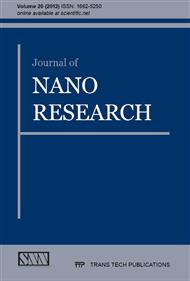[1]
A. Llorens, R. Mateo, M.J. Hinojo, F.M. Valle-Algarra, M. Jiménez, Influence of environmental factors on the biosynthesis of type B trichothecenes by isolates of Fusarium spp. from Spanish crops, Int. J. Food Microbiol. 94 (2004) 43-54.
DOI: 10.1016/j.ijfoodmicro.2003.12.017
Google Scholar
[2]
J.J. Mateo, R. Mateo, M. Jiménez, Accumulation of type A trichothecenes in maize, wheat and rice by Fusarium sporotrichioides isolates under diverse culture conditions, Int. J. Food Microbiol. 72 (2002) 115-123.
DOI: 10.1016/s0168-1605(01)00625-0
Google Scholar
[3]
V.M. Scussel, M. Beber, K.M. Tonon, Efeitos da infecção por Fusarium/Giberella na qualidade e segurança de grãos, farinhas e produtos derivados, in: Giberella em cereais de inverno, 1th edn. Berthier, Passo Fundo, 2011, pp.131-175.
Google Scholar
[4]
J.W. Bennett, M. Klich, Mycotoxins, Clin. Microbiol. Rev. 16 (2003) 497-516.
Google Scholar
[5]
O. Choi, K.K. Deng, N.J. Kim, L. Ross, R.Y. Surampalli, Z. Hu, The inhibitory effects of silver nanoparticles, silver ions, and silver chloride colloids on microbial growth, Water Res. 42 (2008) 3066-3074.
DOI: 10.1016/j.watres.2008.02.021
Google Scholar
[6]
N. Cioffi, N. Ditaranto, L. Torsi, R.A. Picca, E. De. Giglio, L. Sabbatini, L. Novello, G. Tantillo, T. Bleve-Zacheo, P.G. Zambonin, Synthesis, analytical characterization and bioactivity of Ag and Cu nanoparticles embedded in poly-vinyl-methyl-ketone films, Analyt. Bioanalyt. Chem. 382 (2005).
DOI: 10.1007/s00216-005-3334-x
Google Scholar
[7]
L. He, Y. Liu, A. Mustapha, M. Lin, Antifungal activity of zinc oxide nanoparticles against Botrytis cinerea and Penicillium expansum, Microbiol. Res. 166 (2001) 207-215.
DOI: 10.1016/j.micres.2010.03.003
Google Scholar
[8]
Y. Liu, L. He, A. Mustapha, H. Li, Z.Q. Hu, M. Lin, Antibacterial activities of zinc oxide nanoparticles against Escherichia coli O157: H7, J. Appl. Microbiol. l07 (2009) 1193-1201.
DOI: 10.1111/j.1365-2672.2009.04303.x
Google Scholar
[9]
Y. Cui, Y. Zhao, Y. Tian, W. Zhang, W. Lu, X. Jiang, The molecular mechanism of action of bactericidal gold nanoparticles on Escherichia coli, Biomaterials. 33 (2012) 2327-2333.
DOI: 10.1016/j.biomaterials.2011.11.057
Google Scholar
[10]
Q.L. Feng, J. Wu, G.Q. Chen, F.Z. Cui, T.N. Kim, J.O. Kim, A mechanistic study of the antibacterial effect of silver ions on Escherichia coli and Staphylococcus aureus, J. Biomed. Mater. Res. 52 (2000) 662-668.
DOI: 10.1002/1097-4636(20001215)52:4<662::aid-jbm10>3.0.co;2-3
Google Scholar
[11]
R.D. Young, D.B. Leinweber, A.W. Thomas, Leading quenching effects in the proton magnetic moment, Phys. Rev. 71 (2005) 014001-1-014001-9.
DOI: 10.1103/physrevd.71.014001
Google Scholar
[12]
S. Ray, R. Mohan, J.K. Singh, M.K. Samantaray, M.M. Shaikh, D. Panda, P. Ghosh, Anticancer and antimicrobial metallopharmaceutical agents based on palladium, gold, and silver N-heterocyclic carbene complexes, J. Am. Chem. Soc. 129 (2007).
DOI: 10.1021/ja075889z
Google Scholar
[13]
S. Perni, C. Piccirillo, J. Pratten, P. Prokopovich, W. Chrzanowski, I.P. Parkin, M. Wilson, The antimicrobial properties of light-activated polymers containing methylene blue and gold nanoparticles, Biomaterials 30 (2009) 89-93.
DOI: 10.1016/j.biomaterials.2008.09.020
Google Scholar
[14]
Y. Zhang, H. Peng, W. Huang, Y. Zhou, D. Yan, Facile preparation and characterization of highly antimicrobial colloid Ag or Au nanoparticles, J. Colloid Interface Sci. 325 (2008) 371-376.
DOI: 10.1016/j.jcis.2008.05.063
Google Scholar
[15]
S. Pal, Y.K. Tak, J.M. Song, Does the antibacterial activity of silver nanoparticles depend on the shape of the nanoparticle? A study of the gram-negative bacterium Escherichia coli, Appl. Environ. Microbiol. 73 (2007) 1712-1720.
DOI: 10.1128/aem.02218-06
Google Scholar
[16]
T.A. Taton, C.A. Mirkin, R.L. Letsinger, Scanometric DNA Array Detection with Nanoparticle Probes, Science. 289 (2000) 1757-1760.
DOI: 10.1126/science.289.5485.1757
Google Scholar
[17]
E.E. Connor, J. Mwamuka, A. Gole, C.J. Murphy, M.D. Wyatt, Gold nanoparticles are taken up by human cells but do not cause acute cytotoxicity, Small. 1 (2005) 325-7.
DOI: 10.1002/smll.200400093
Google Scholar
[18]
T. Niidome, D. Pissuwan, M.B. Cortie. The forthcoming applications of gold nanoparticles in drug and gene delivery systems, J. Control Release. 149 (2011) 65-71.
DOI: 10.1016/j.jconrel.2009.12.006
Google Scholar
[19]
A.K. Dasgupta, H.K. Patra, S. Banerjee, U. Chaudhuri, P. Lahiri, Cell selective response to gold nanoparticles, Nanomed. Nanotechnol. 3 (2007) 111-9.
Google Scholar
[20]
S. Shortkroff, M. Turell, K. Rice, T.S. Thornhill, Cellular response to nanoparticles, Mater Res. Soc. Symp. Proc. 704 (2002) 375-80.
DOI: 10.1557/proc-704-w11.5.1
Google Scholar
[21]
J. Turkevich, P.C. Stevenson, J. Hillier, A study of the nucleation and growth process in the synthesis of colloidal gold, Discuss. Faraday. Soc. 11 (1951) 55-75.
DOI: 10.1039/df9511100055
Google Scholar
[22]
D. Fraternale, L. Giamperi, D. Ricci, Chemical composition and antifungal acivity of essential iol obtained from in virto plants of Thymus mastichina L, J. Essent. Oil Res. 15 (2003) 278-81.
DOI: 10.1080/10412905.2003.9712142
Google Scholar
[23]
A. Mishra, S.K. Tripathy, R. Wahab, S.H. Jeong, I. Hwang, Y.B. Yang, Y.S. Kim, H.S. Shin, S.I.L. Yun, Microbial synthesis of gold nanoparticles using the fungus Penicillium brevicompactum and their cytotoxic effects against mouse mayo blast cancer C2C12 cells, Appl. Microbiol. Biotechnol. 92 (2011).
DOI: 10.1007/s00253-011-3556-0
Google Scholar
[24]
P. Baptista, E. Pereira, P. Eaton, G. Doria, A. Miranda, I. Gomes, P. Quaresma, R. Franco, Gold Nanoparticles for the development of clinical diagnosis methods, Analyt. Bioanalyt. Chem. 3 (2008) 943-50.
DOI: 10.1007/s00216-007-1768-z
Google Scholar
[25]
M. Vidotti, R.F. Carvalhal, R.K. Mendes, D.C.M. Ferreira, L.T. Kubota, Biosensors based on gold nanostructures, J. Braz. Chem. Soc. 1 (2011) 3-20.
DOI: 10.1590/s0103-50532011000100002
Google Scholar
[26]
A. Jyoti, P. Pandey, S.P. Singh, S.K. Jain, R. Shanker, Colorimetric detection of nucleic acid signature of shiga toxin producing E. coli using Au NPs, J. Nanosci. Nanotechnol. 7 (2010) 4154-4158.
DOI: 10.1166/jnn.2010.2649
Google Scholar
[27]
C. Suryanarayana, M.G. Norton, X-ray Diffraction: a Practical Approach. New York: Plenum Press, 1998, p.273.
Google Scholar
[28]
H.W. Gu, P.L. Ho, E. Tong, L. Wang, B. Xu, Presenting vancomycin on nanoparticles to enhance antimicrobial activities, Nano. Letters. 9 (2003)1261-1263.
DOI: 10.1021/nl034396z
Google Scholar


